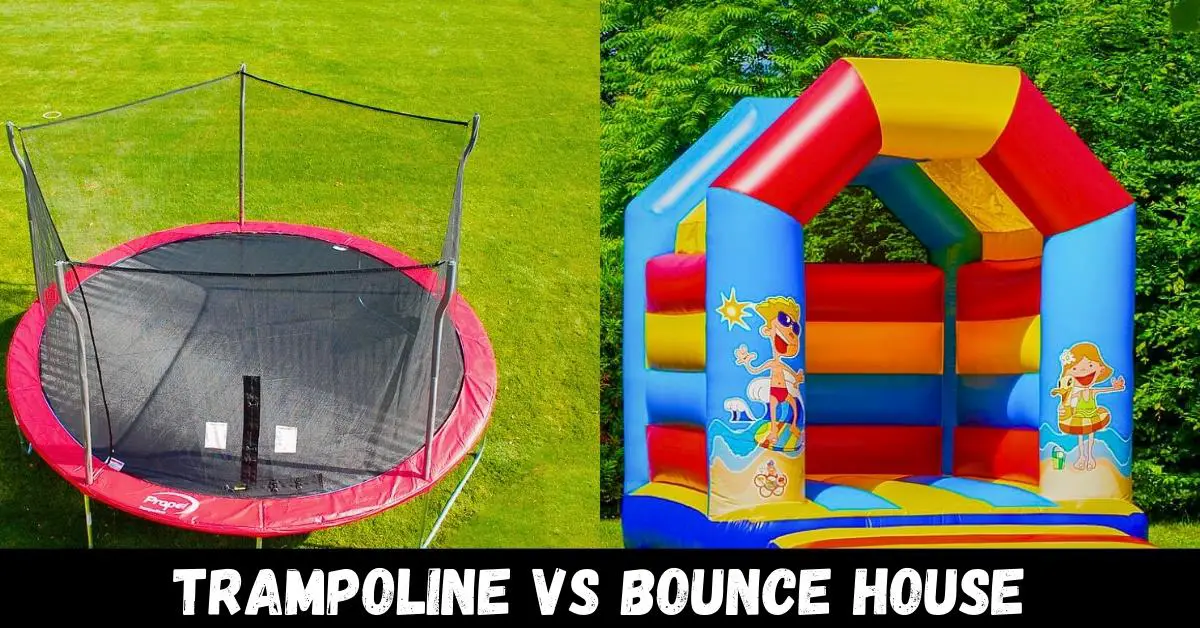When I look at a trampoline vs. a Bounce house, it’s easy to mistake them for being the same thing. However, upon closer inspection, I realize they are actually quite different.
You see, a trampoline is a fantastic piece of equipment that I love using. It consists of a fabric bed stretched over a sturdy metal frame using springs.
On the other hand, bounce houses are these incredible inflatable structures that are often the highlight of children’s parties or other fun events. Made from durable vinyl or other materials, they provide a bouncy and exciting environment for everyone to enjoy.
What sets them apart is that trampolines are usually designed for one person (sometimes two). At the same time, bounce houses can accommodate multiple people, creating a lively atmosphere full of laughter and shared experiences.
Trampoline Vs. Bounce House: The key differences lie in their structure and usage when comparing a trampoline and a bounce house. Trampolines feature a fabric bed on a metal frame with springs, while bounce houses are inflatable structures for entertainment at events and parties.
Are Bounce Houses Effective for Exercise?
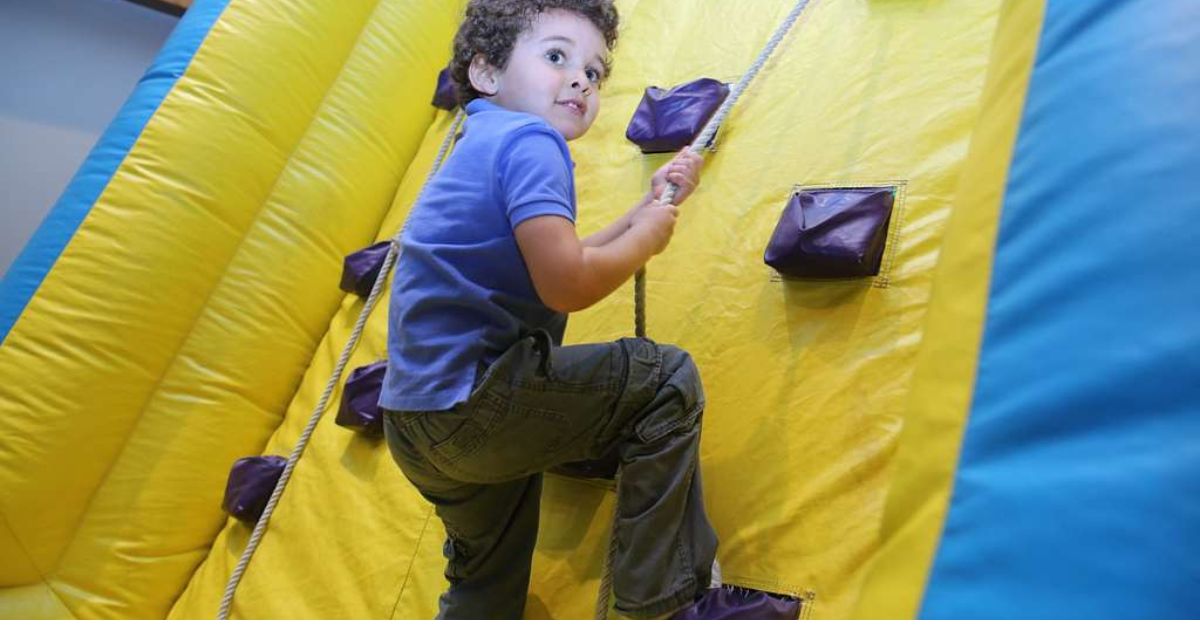
Bounce houses can be a fun way to get some exercise, but they are not as physically challenging as trampolines. This makes them more suitable for younger children who may not have the coordination and motor skills required for a trampoline.
However, adults can still get a decent workout by regularly using bounce houses. If you’re looking for a more intense workout, a trampoline would be a better choice compared to a bounce house.
Is there a risk of suffocation in a Bounce House?
There have been instances where children have gotten stuck and had difficulty breathing inside bounce houses. This usually occurs when the bounce house is not fully inflated, when a child is too small for the bounce house, or when there isn’t proper supervision.
Ensuring the bounce house is fully inflated before use is crucial to prevent this. Only allow children who are big enough and old enough to safely use the bounce house. Additionally, always have at least one adult closely watching the children while they play in the bounce house.
What is the lifespan or durability of a Bounce House?
Typically, bounce houses can last for about 500 hours of use, although this can vary based on factors like quality, frequency of use, and weather conditions.
To ensure the longevity of a bounce house, it’s important to regularly check for leaks along the seams and promptly patch any holes. A bounce house may not last as long as expected if not properly maintained. Comparatively, bounce houses usually require more frequent replacement compared to trampolines.
Bounce houses are typically made of PVC or nylon, while trampolines are made of steel. Because of this, bounce houses are more prone to damage from weather conditions. To protect them, it’s advisable to use them in dry, sheltered areas and store them indoors when not in use.
Is there a risk of getting stuck in a Trampoline?
It’s highly unlikely to get stuck on a trampoline unless it is damaged or improperly maintained. Trampolines are designed with springs that stretch the mat, so if you fall through the middle, you will bounce back up.
However, it’s important to regularly check the trampoline’s condition and replace any damaged parts to ensure safety.
If you do get stuck, you can simply reach up and grab the mat to pull yourself out. Just be cautious and keep your hands and feet away from the springs.
You can consider purchasing a trampoline with a safety enclosure for added peace of mind. This will prevent falling through the middle and provide extra protection against injuries.
Is it safe to place a Bounce House on Concrete?
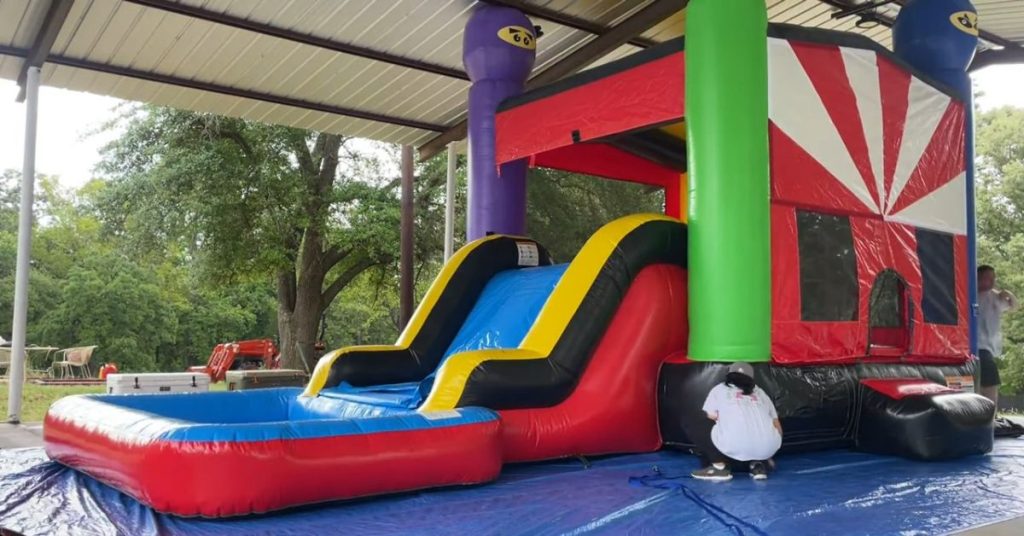
Placing a bounce house on concrete is not recommended because it is a hard surface that can lead to serious injuries if a child falls. Setting up a bounce house on grass or soft surfaces is much safer.
If you must use a bounce house on concrete, it’s advisable to add a layer of padding, like cardboard or bubble wrap, to provide some cushioning.
On the other hand, trampolines can be used on concrete, but precautions must be taken. The concrete surface should be level and free of any debris to ensure safety.
Additionally, placing padding beneath the trampoline, such as cardboard or bubble wrap, can protect the concrete from damage. Remember to also ensure the trampoline is securely anchored and cannot tip over.
Is it necessary to Anchor Bounce Houses?
For safety reasons, it is essential to anchor all inflatable structures, including bounce houses, properly. If a bounce house is not anchored correctly, it can be blown away by strong winds or collapse, leading to severe injuries.
It is crucial to follow the manufacturer’s instructions carefully to ensure proper anchoring. Typically, stakes or sandbags are used to secure the bounce house firmly to the ground.
Similarly, trampolines also require proper anchoring to prevent accidents. If a trampoline is not securely anchored, it can tip over during strong winds or collapse, posing a significant risk of injury.
To anchor a trampoline effectively, following the manufacturer’s instructions is important. Typically, stakes or sandbags are used to ensure the trampoline remains stable and safe during use.
Can Trampolines damage the Grass Underneath them?
Trampolines have the potential to damage grass, but you can prevent this by using a trampoline pad. The pad, made of rubber or foam, goes underneath the trampoline to protect the grass from getting punctured.
If you don’t have a trampoline pad, you can lay down some padding like cardboard or bubble wrap on the grass before setting up the trampoline. This will safeguard the grass and make it safer for kids to play.
Remember to regularly inspect the trampoline mat and replace it if it’s damaged. A worn-out or damaged mat can expose the springs, harming the grass.
Generally, bounce houses are less damaging to grass than trampolines because they lack sharp edges. However, if a bounce house isn’t properly inflated, it might collapse and cause damage.
Also, keep an eye on the wear and tear on the grass or dirt underneath the bounce house, as excessive damage could indicate the need to relocate it.
Trampoline vs Bounce Houses: Comparison
Trampolines and bounce houses are enjoyable and entertaining equipment, but they differ. Here’s a comparison between trampolines and bounce houses:
Installation Process:
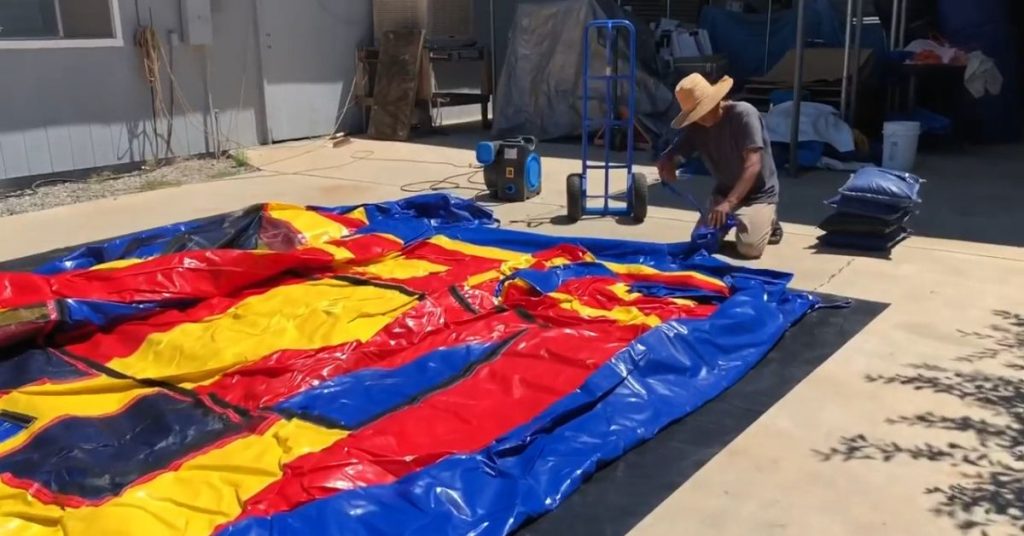
Setting up a trampoline can be a bit of work. You start by assembling the frame and attaching the legs. Then, you flip the trampoline over and connect the springs and mat. This may require some effort and possibly two people to help.
Once the trampoline is set up, you mustn’t take it down all year. It stays in place and is ready for use whenever you want to bounce.
On the other hand, setting up a bounce house is different. You must lay it out in the desired location and turn on the inflation machine. You wait until the bounce house is fully inflated, which usually takes less time. One person can handle the setup process.
However, the bounce house cannot be left up all the time. It’s sensitive to cold weather and shouldn’t be used in winter. Additionally, using the bounce house during rainy weather is unsafe. So, you need to set it up and take it down each time you want to use it.
Considering the setup time and convenience, the trampoline wins in this aspect, as it only needs to be set up once and can stay in place throughout the year.
Pricing:
The cost of a trampoline can vary depending on its size and additional features. It can range from around $300 to a few thousand dollars. For instance, a 12-foot trampoline from Skywalker Trampoline costs $319, while a 17-foot trampoline costs $1,295.
The price may increase if you want to include accessories like a safety net, spring cover, basketball hoop, or triple toss game.
Similarly, bounce houses also have a wide range of prices. A small AirMyFun bounce house can be purchased for under $200 on Amazon, while a larger 23-foot by 16-foot bounce house can cost just under $7,000.
Considering the variety of pricing options and sizes available, bounce houses have an advantage in terms of affordability and flexibility.
Occupancy Limit:
Regarding trampolines, it is generally advised to have only one person on it at a time. However, people often disregard this recommendation and simultaneously have multiple people on the trampoline.
But keep in mind that the more people on the trampoline, the more difficult it becomes to use it effectively.
On the other hand, bounce houses are designed to accommodate more than one person at a time. Each bounce house has a recommended maximum number of people who can use it together.
While there can be a limit to how many people can use a bounce house comfortably, the capacity is typically higher than that of a trampoline.
In simpler terms, trampolines are usually meant for one person at a time, but people often use them with more. On the other hand, bounce houses are designed for multiple people to enjoy simultaneously, with a higher capacity than trampolines.
Longevity:
Durability is an important aspect to consider when choosing between a trampoline and a bounce house.
When you invest in a trampoline or a bounce house, you want it to withstand the energetic jumping of your kids and their friends and last for a long time. This is especially true considering the amount of money you spend on it.
Trampolines generally require less maintenance and can be set up and left outside throughout the year without much effort on your part. Even if they experience rips, tears, or broken springs, these issues can usually be fixed easily, and the trampoline remains usable.
On the other hand, bounce houses need more maintenance. You need to regularly check and repair any broken seams or holes that may occur for various reasons. If there is a broken seam, the bounce house cannot be used until it is fixed.
Additionally, if you have to move the bounce house in and out of storage each time your kids want to use it, there is a higher likelihood of it getting damaged.
When it comes to replacing parts, trampolines offer more convenience. You can easily purchase replacement parts and quickly fix anything that gets broken. Bounce houses, however, may require more complex repairs for damaged seams or holes.
In simpler terms, trampolines are generally more durable and easier to maintain, with easily replaceable parts. Bounce houses require more upkeep; if they develop a broken seam, they become unusable until repaired. Moving a bounce house frequently can also increase the chances of damage.
Usage:
One important factor to consider when choosing between a trampoline and a bounce house is how often you and your family will use it.
As we mentioned before, once a trampoline is set up, it requires minimal maintenance. It is sturdy and can be left outside year-round, allowing for year-round use.
While jumping on a trampoline when it’s covered in snow or rain is not recommended, you can easily remove the snow or cover it with a tarp to protect it from rain. This means that a trampoline can be used regularly, even daily.
On the other hand, a bounce house is different. It’s not meant to be left inflated constantly because it relies on an air pump that must be turned on continuously. This constant use of electronics can wear them out over time.
So, while you may have the bounce house outside, it won’t be ready for immediate use. Depending on its size, it can take some time to inflate before it’s ready for jumping.
For example, we once went to someone’s house with a bounce house, and it took an hour to fill it up before we could use it. This means that you need to plan ahead and allow time for inflation if you know you want to use the bounce house.
Unlike a trampoline, you can’t just go outside and start bouncing on it whenever you want.
In simpler terms, a trampoline can be used regularly throughout the year, even daily, with minimal setup time. However, a bounce house requires planning and time for inflation before it can be used, and it’s not meant to be left inflated all the time.
Upkeep:
Trampolines require specific maintenance throughout the year to keep them in good condition.
First, it’s important to perform regular maintenance, although many people tend to overlook this step. You should check the screws on the trampoline frame and legs regularly. Tighten any loose screws and replace any that are missing.
Regularly inspect the springs and replace any old or rusted ones before they become a problem. Before anyone jumps on a trampoline covered in snow, make sure to brush off the snow with a broom. If the trampoline mat or safety net gets a hole, patch it up before it gets bigger.
On the other hand, bounce houses require different maintenance since they won’t be set up all year like trampolines. Regularly check the bounce house for burst seams.
If you find any, you must sew them back together using a needle and thread. Using a sewing machine might not be practical.
The air pump used to inflate the bounce house is crucial. You can’t use any machine for this purpose. The bounce house usually has a specific air pump, but the pump can break down.
If the air pump stops working, you’ll need to fix it, find someone to repair it, or purchase a new one. None of these options are simple or cheap.
In simpler terms, trampolines need regular checks on screws and springs, snow removal, and patching of any holes. Bounce houses require inspecting, and sewing burst seams, and the air pump used to inflate them can break down, requiring repairs or a replacement.
Security:
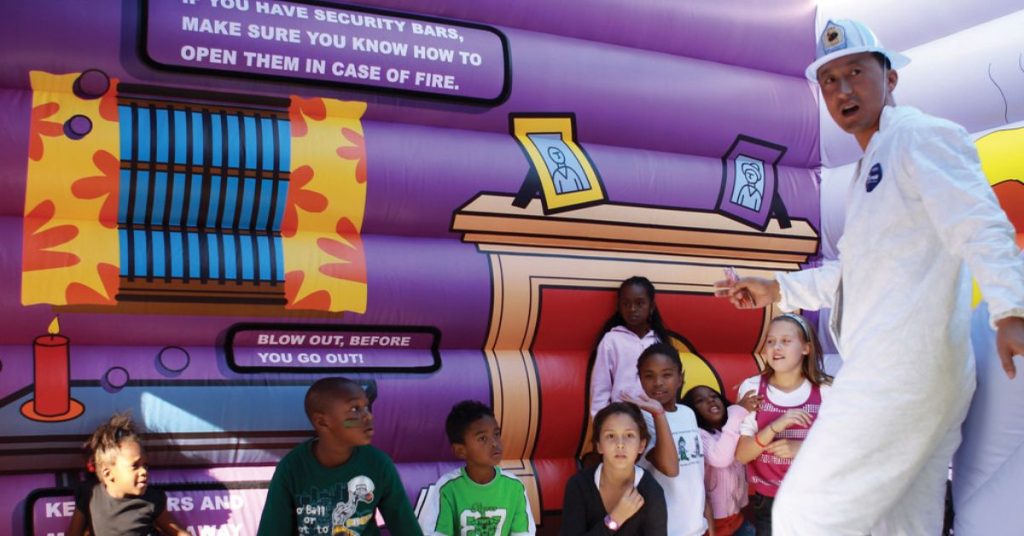
Buying a trampoline usually includes basic components like the net, frame, and springs. However, for added safety, you can choose to purchase additional accessories.
For example, a safety net can greatly reduce the risk of injuries by preventing people from falling off the trampoline. A spring pad can protect jumpers from accidentally landing on the springs, which can be dangerous.
On the other hand, bounce houses are generally safe on their own. The concept of a bounce house is that it’s inflated with air, providing a soft surface for kids to bounce on. Bounce houses are typically enclosed, making it difficult for someone to get hurt.
However, accidents can still happen. For instance, if too many people jump inside, someone might accidentally land on or collide with another person, potentially causing injuries. So, while bounce houses are generally safe, caution is still necessary.
It’s important to note that there are limited options to add extra safety features to a bounce house, as they are designed to be safe from the start.
Overall, regarding safety, the advantage goes to bounce houses due to their enclosed design and generally lower risk of injuries.
Frequency of Utilization:
Bounce houses may seem popular, but their appeal is often tied to special occasions like parties and fairs. They are large, impressive, and colorful, making them attractive for those events.
On the other hand, trampolines are more commonly found in backyards across the country and are not considered as “special.”
Children are more likely to spontaneously go out and play on a trampoline rather than wait for a bounce house to be set up. While bounce houses can provide a fun afternoon, they are usually reserved for specific occasions rather than everyday use.
Another factor to consider is that children can outgrow small bounce houses relatively quickly. These smaller bounce houses are designed for young children and may not accommodate them as they age.
Trampolines, however, can be enjoyed by both children and young adults as long as they follow safety guidelines and weight limits.
Trampolines are more likely to win over bounce houses in terms of casual and frequent use. However, a small bounce house can still offer plenty of enjoyment for a couple of summers before it is eventually retired.
Renting vs. Buying:
When considering whether to get a trampoline or a bounce house, one important factor to consider is whether to rent or buy it. This decision revolves around factors like cost, storage, and maintenance.
Trampolines are commonly found in many households across America. Most people choose to buy a trampoline rather than rent one. However, renting a trampoline is also an option, as some companies offer rental services for trampolines and bounce houses.
On the other hand, bounce houses are typically rented rather than bought, especially for larger ones. Unlike trampolines, bounce houses require storage and care and are usually used for special occasions.
Buying a trampoline is a more cost-effective choice in terms of money, time, and space. Renting a trampoline can be more expensive in the long run, especially if you plan to use it for over a few years.
Conversely, renting a bounce house is often a better option. Bounce houses are associated with special occasions and can be expensive.
Also, dealing with a bounce house’s setup, teardown, and storage can be cumbersome for most parents. Renting a bounce house simply makes more sense in these cases.
What are the possibilities for play and enjoyment?
Bounce houses have an advantage in terms of attractiveness because they come in different colors, shapes, and designs. They can also have additional features like slides, basketball hoops, and ball pits, which make them very appealing to children, especially during parties.
Bounce houses can accommodate multiple children playing simultaneously without causing injuries.
Trampolines, on the other hand, provide a simple circular space for jumping. However, you can enhance the trampoline experience by adding accessories like basketball hoops or water sprinklers.
In terms of playability, bounce houses offer a wider range of activities and facilities compared to trampolines. They provide more variety and options for fun.
However, trampolines should not be considered boring. They offer various activities and games that can make trampolining enjoyable. Moreover, trampolines have the advantage of being suitable for a child’s growth and development over time.
Kids can continue to use trampolines as they grow, whereas bounce houses are typically outgrown. Trampolines can help children develop healthy mechanisms and skills that can be valuable throughout their lives.
What are the Advantages of Physical Health and Well-Being?
Bouncing on bounce houses and trampolines offers several health benefits. It is a fun way for children to burn off energy and stay active. With their additional activities, bounce houses can help children engage more muscles and develop acrobatic skills in a safe environment.
However, it’s important to consider that bounce houses can feel suffocating because of their enclosed design. On the other hand, trampolines provide a more liberating experience. Trampolines are also more physically demanding, which can contribute to long-term physical development.
Jumping, a common activity on bounce houses and trampolines, offers multiple health benefits. It engages your entire body, making different muscles work together. Jumping can improve bone density, enhance balance, and boost heart health.
So, jumping provides various health benefits for children, whether on a bounce house or a trampoline.
Which one requires more Maintenance Efforts?
When it comes to taking care of them, trampolines are much easier to maintain. Once you set up a trampoline, you can leave it in place throughout the year with occasional cleaning to remove dirt, snow, and leaves accumulated over time.
While trampolines are generally durable, you must check the springs, jumping mat, nuts, bolts, and other components for any damage or wear and tear. If the jumping mat tears or springs break, they can easily be repaired or replaced.
On the other hand, maintaining a bounce house can be quite challenging. Bounce houses are not a one-time setup. They need to be inflated every time you want to use them, and after the party or playtime is over, they have to be deflated, rolled up, and stored safely.
Bounce houses are typically made of strong inflatable materials that can withstand a lot of pressure. However, they are still susceptible to tearing. Additionally, bounce houses have many components that require regular inspection and maintenance.
It’s also important to consider that bounce houses may not be a good long-term investment. For example, if you have a small bounce house suitable for children, they may outgrow it quickly.
On the other hand, trampolines can be used for many years and are even enjoyed by adults for regular use.
Which Option Provides Better Safety for Your Child: Bounce Houses or Trampolines?
When deciding between a bounce house and a trampoline, it’s important to consider safety precautions. Both options can be used safely, but it’s crucial to follow the instructions provided by the manufacturer.
Bounce houses are generally considered safer than trampolines, but they still carry some risks. Properly anchoring the bounce house is essential to prevent it from blowing away or collapsing.
Trampolines, on the other hand, have stricter age restrictions. Bounce houses are typically recommended for children aged 6 and older, while trampolines can be used safely by children as young as 3 years old. Trampolines also offer more health benefits compared to bounce houses.
So, which option is better for your child? It depends on their age and interests. A trampoline might be a good choice if you have a young child who wants to have fun while getting a bouncy workout.
Regardless of your choice, adult supervision is crucial. Never leave your child unattended on a bounce house or trampoline, regardless of their age. Both options require regular maintenance and safety checks. Replace any worn-out or damaged parts promptly to avoid accidents.
Remember to follow the manufacturer’s setup, use, and maintenance instructions carefully. And always ensure there is adult supervision! Both bounce houses and trampolines can provide hours of fun for your children as long as they are used safely.
Factors to Consider When Choosing Between Trampoline and Bounce House
Here are the several factors to consider when choosing between a trampoline and a bounce house:
Age and Size of Users: Trampoline suits older kids and adults, while bounce houses are safer for younger children.
Available Space and Location: Trampolines need a dedicated outdoor area, while bounce houses can be used indoors or outdoors.
Safety Concerns: Trampolines have a higher injury risk, necessitating safety enclosures, while bounce houses require proper anchoring and supervision.
Budget and Cost Considerations: Trampolines can be more expensive upfront, whereas bounce houses are often more budget-friendly.
Purpose and Intended Use: Trampolines are ideal for regular exercise and recreation, while bounce houses are great for parties and social play.
Maintenance and Care
Maintenance and care are essential for ensuring the longevity, safety, and optimal performance of both trampolines and bounce houses. To keep your trampoline in top condition, conduct regular inspections to check for wear, tear, or damage in the frame, springs, jumping mat, safety enclosure, and padding.
Additionally, make sure to clean the trampoline regularly, removing debris and dirt from the jumping surface and safety padding. During adverse weather conditions, consider using weather covers to protect the trampoline.
Don’t forget to tighten bolts and nuts periodically to maintain stability. Adhere to the weight limit recommendations to avoid putting excessive stress on the trampoline components, and consider disassembling and storing it indoors during the off-season in areas with extreme weather
For bounce houses, cleanliness is of utmost importance. Clean the bounce house regularly with mild soap and water to remove dirt, stains, and bacteria, and ensure it is completely dry before storage to prevent mold and mildew growth.
Before each use, inspect the bounce house for any holes, tears, or damage and repair any issues promptly using a repair kit. Properly anchor the bounce house to the ground to prevent movement or tipping over during play, and enforce the weight limit guidelines to avoid overloading.
When not in use, store the deflated bounce house in a dry and clean area, away from direct sunlight and sharp objects.
Following these maintenance and care guidelines will not only ensure the safety of users but also extend the lifespan of the equipment, making it a valuable investment.
Always consult the manufacturer’s specific maintenance instructions for your particular trampoline or bounce house model.
FAQs:
Q:1 Which option, bounce house or trampoline, is considered safer for children?
Trampolines are usually seen as less safe compared to bounce houses for a couple of reasons. First, trampolines have a sturdy steel frame, unlike bounce houses that rely solely on air pressure for support.
Second, without a safety net, trampolines can risk a child being thrown off and landing on the ground in a dangerous manner.
Q:2 What is the recommended age for using a bounce house?
Children who are younger than six years old should avoid playing in bounce houses. It is recommended to have small groups of children, preferably fewer than four, who are of similar size and age, playing together simultaneously.
However, the safest way to play is to have only one child using the bounce house at a time.
Q:3 What is the reason behind wearing socks in a bounce house?
It is important to wear socks while jumping on trampolines. When you jump barefoot, you risk transmitting bacteria or viruses. Additionally, bare feet can make the trampoline sweaty and unhygienic.
By wearing Jump-In socks, you keep your feet clean and help us maintain cleanliness on our equipment.
Q:4 Why is it not allowed to wear shoes in a bounce house?
It’s important to take off your shoes before entering a bounce house. If children wear shoes inside the bounce house, there is a higher risk of tripping and injuring their ankles.
Bounce houses are made of plastic and rubber, and when the rubber soles of shoes come into contact with the bounce house’s surface, it can cause a child to abruptly stop and potentially get hurt.
Q:5 At what age are children typically able to enjoy bouncy castles?
Bounce houses are usually safe for kids aged 6 to 13. However, children younger than 6 years old are at a higher risk of getting injured while playing in bounce houses.
It’s important to remember that children who can’t stand or walk on their own should not use bounce houses, as they might get knocked down by jumping or other children bouncing, which could lead to falls and accidents.
Conclusion:
In conclusion, trampolines and bounce houses offer unique benefits and considerations for children’s play. Trampolines provide a thrilling jumping experience, promoting physical development and acrobatic skills.
However, they require diligent maintenance and precautions for safety. Bounce houses offer a range of activities, making them appealing for parties and safe play. However, they require frequent setup and storage.
Factors like safety, playability, maintenance, and cost should be considered when deciding between trampolines and bounce houses. Both options have advantages and limitations, and following manufacturer guidelines and providing supervision is essential.
Ultimately, the choice depends on individual preferences, the child’s age, available space, and budget. By considering these factors, parents can decide on a fun and safe play experience.
After reading this comprehensive article, we hope you will be well aware of trampoline vs Bounce House. If you have any questions, feel free to comment below!

